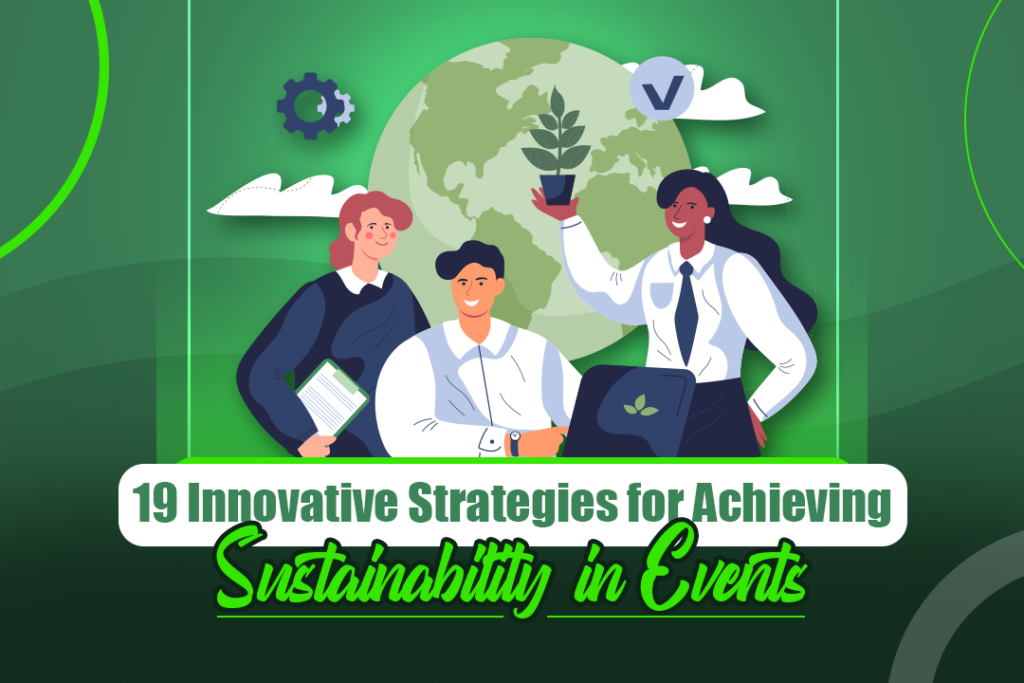
The need for event sustainability in events is growing quickly in today’s changing world. More and more people and groups realize the need to protect the environment. The events industry is showing the way by simultaneously celebrating and protecting the environment.
In this article, we examine event sustainability. We present 19 innovative ideas for improving the attendee experience and protecting our planet for future generations.
These strategies can be used by event planners and enthusiasts to plan events. They cover everything from new technologies to community initiatives and highlight the remarkable opportunities that arise when sustainability plays a central role in every facet of event planning and execution.
What is a sustainable event?
A sustainable event is an organized event that is carefully planned and executed to minimize its environmental impact, promote social responsibility, and contribute positively to the economy. These events balance fun, being ethical, and caring for resources, including everyone.
A sustainable event aims to achieve a harmonious convergence between event objectives and environmental responsibility, social justice, and economic viability.
Current Environmental Impact of Events
According to a report supported by Forbes–
- A study from 2019 looked at a big conference with 800 people that lasted three days.
- This conference created a lot of carbon dioxide (CO2), which is bad for the environment. It was as much CO2 as 95 cars make in a year.
- Conferences also produce a lot of garbage, including leftover food and other materials that are used by attendees.
Organizing a sustainable and environmentally friendly event may decrease the grave impact of events on the ecosystem. A study by the Events Industry Council found that implementing sustainable practices can result in a 20-30% reduction in costs and a 60-80% reduction in waste. One can achieve these targets when implementing innovative strategies to integrate sustainability into events. Let’s look at them in detail below.
19 Innovative Ideas to Integrate Sustainability in Events
Here are 19 innovative ideas that will help integrate sustainability into events-
1. Carbon-Reduced Entertainment
Opting for low-carbon entertainment options aligns events with sustainability goals and reduces environmental impact. For example, let’s have a look at how AEG, one of the world’s largest sports and live entertainment companies, focuses on carbon reduction in its venue operations. AEG venues, including arenas and stadiums, have adopted energy-efficient technologies, LED lighting, and sustainable practices to minimize their carbon footprint. Additionally, AEG invests in renewable energy sources, such as solar panels, to power their venues. This commitment to carbon reduction aligns with environmental goals and enhances the entertainment industry’s overall sustainability.
When you choose eco-friendly entertainment, you can make your event greener by using less energy and creating fewer emissions. Keep reading to learn about a few strategies to implement in your next conference-
- Acoustic and Local Talent: Feature low-tech acts and local performers to reduce emissions. Acoustic acts typically require fewer electronic amplifications, reducing energy consumption. Additionally, featuring local artists minimizes the need for extensive travel, lowering carbon emissions associated with transportation.
- Interactive Workshops: Engage attendees with eco-conscious activities and creative sessions. These sessions can focus on sustainable practices, DIY projects using recycled materials, or discussions on environmental conservation.
- Virtual Options: Offer remote entertainment to limit travel-related carbon emissions. Virtual events, live streams, or online participation enable global audiences to engage without the need for extensive travel.

- Energy-Efficient Setups: Opting for energy-efficient setups involves using LED lighting, which consumes less energy and has a longer lifespan than traditional lighting. Additionally, choosing sustainable materials for stage design, such as recycled or locally sourced materials, reduces the environmental impact of event production.
- Educational Engagement: Integrate entertainment that raises awareness about environmental issues. This can be achieved through performances, documentaries, or interactive exhibits that communicate sustainability messages, fostering a sense of responsibility among attendees.
2. Zero-Waste Initiatives
Amid escalating environmental concerns, integrating zero-waste strategies into event planning is paramount. These tactics aim to slash waste generation and promote eco-conscious behaviors.
Organizers can shrink event footprints by embracing innovation and inspiring attendees toward sustainable habits. These collective actions pave the path for a greener future. Let’s look at some of them below.
- Composting Stations: Create designated areas for food waste and biodegradable items to divert them from landfills. Let’s have a look at how Salesforce adopted this approach in their conference. Salesforce, a leading cloud-based software company, implemented comprehensive zero-waste initiatives during its annual Dreamforce conference in 2019. The company introduced reusable and compostable serviceware, eliminated single-use plastics, and set up waste stations with clear signage to encourage proper waste disposal. Through collaboration with local composting facilities, Salesforce achieved an impressive 90% diversion rate from landfills during the event.
- Sorting Education: Educate attendees about waste separation to improve recycling and composting. This can include placing well-labeled bins for different types of waste, such as recycling, compost, and landfill. Event organizers can promote responsible disposal practices by adopting this method, leading to improved recycling and composting rates.
- Waste Audits: Conduct post-event assessments to measure progress and refine strategies. This helps measure the effectiveness of zero-waste initiatives. By identifying areas for improvement, event organizers can refine strategies for future events.
- Donation Programs: These events redirect excess food from events to local charities or community organizations. This minimizes food waste and contributes to addressing food insecurity in the community. Event organizers can collaborate with local food banks or charities to establish processes for safely collecting and redistributing surplus food.
3. Virtual Attendance Options
In response to changing event dynamics, virtual attendance options have emerged as a sustainable solution. They allow participants to engage remotely, curbing travel-related emissions and expanding event accessibility.
For example- Cisco, a global technology leader, offers the WebEx virtual event platform that enables organizations to host sustainable virtual conferences, trade shows, and meetings. Companies can significantly reduce the carbon footprint associated with travel by promoting virtual attendance options. Cisco’s WebEx provides a user-friendly interface, interactive features, and robust security measures, making it an ideal choice for businesses embracing sustainable event practices.
This approach fosters inclusivity and aligns with environmentally conscious practices. Check out our articles on – virtual speaking, virtual etiquette, and networking to master your virtual option.
- Hybrid Formats: Hybrid formats offer a flexible approach by combining in-person and virtual elements. Attendees can choose between attending physically or participating virtually, providing a more inclusive experience for a diverse audience. This format enhances accessibility, allowing individuals facing geographical or logistical constraints to engage with the event.

- Global Reach: Virtual attendance extends the reach of events beyond geographical limitations. People from different parts of the world can participate without the need for extensive travel. This not only increases the diversity of the audience but also facilitates global collaboration and knowledge-sharing.
- Resource Efficiency: Virtual attendance options minimize resource consumption by using digital platforms for communication, collaboration, and information sharing. This reduces the need for printed materials, physical infrastructure, and other resources associated with traditional events, contributing to a more resource-efficient and sustainable approach.
- Economic Advantages: Offering virtual attendance options appeals to budget-conscious attendees by eliminating travel-related expenses such as transportation, accommodation, and meals.
- Low-Waste Approach: Embrace virtual resources to reduce printed materials and event waste. Information, presentations, and materials can be delivered digitally, reducing the generation of event waste.
4. Renewable Energy Sources
Embracing renewable energy sources in event planning is a pivotal step toward sustainable practices. Events can switch from fossil fuels to cleaner energy options to reduce their carbon footprint. Implementing renewable energy sources benefits the environment and the event industry’s long-term viability. Learn about some renewable strategies below-
- Diverse Sources: Diversifying energy sources is key to a comprehensive renewable energy strategy. Solar, wind, hydro, geothermal, and biomass are viable and sustainable alternatives to fossil fuels. Events can contribute to a cleaner energy mix by harnessing energy from these renewable sources.
- Innovative Solutions: Embracing innovative solutions such as power purchase agreements (PPAs) and microgrid systems enhances energy use efficiency. PPAs enable events to purchase renewable energy directly from providers, supporting the growth of clean energy infrastructure. Microgrid systems, on the other hand, offer localized and resilient energy solutions, providing flexibility and reliability in energy distribution.
- Cost Savings: While an initial investment in renewable energy infrastructure may be necessary, the long-term benefits include cost savings. Sustainable energy sources often become more cost-effective over time, reducing operational expenses. Additionally, adopting renewable energy enhances the brand image of events, appealing to environmentally conscious attendees and sponsors.
5. Green Catering
Adopting green catering practices transforms events into eco-conscious experiences. By prioritizing sustainability in food sourcing, preparation, and waste management, events can reduce their environmental footprint and promote responsible consumption.
Green catering meets the needs of customers who want ethical and eco-friendly choices. You can adopt these green catering practices for your next event-
- Sustainable Sourcing: Adopting these practices involves prioritizing local and organic ingredients for event menus. This method also helps reduce the carbon footprint associated with livestock farming.
- Educational Engagement: Incorporate educational displays within the catering setup to inform attendees about sustainable practices and the environmental impact of food choices. Events can inspire attendees to make more informed and responsible consumption decisions, fostering a culture of sustainability.
- Environmental Impact: Aligning event catering with eco-conscious values involves making intentional choices that support sustainability and responsible food practices. This reduces the environmental impact of events and reinforces a commitment to ethical and eco-friendly values, contributing to a more sustainable and responsible event industry.
6. Vegan and Vegetarian Options
A study published by the University of British Columbia describes the impact of meat production but “not limited to the pollution of the atmosphere through fossil fuel usage, methane produced by animals, land degradation, water consumption and the clearing of forests to make way for grazing pastures.”
Providing only vegan and vegetarian options is a good way to reduce your event’s carbon footprint. As an event organizer, let’s look at a few ways to incorporate a diverse and enticing array of vegan and vegetarian food options into event catering-
- Diverse Menu Options: Offering a diverse range of vegan and vegetarian menu options is a strategic approach to accommodate the varied dietary preferences and restrictions of event attendees. This initiative goes beyond providing basic salads and sides, aiming to create a rich and inclusive culinary experience for everyone. The idea is to collaborate with caterers to design a menu that is not only plant-based but also flavorful, satisfying, and nutritionally balanced.

- Local Plant-Based Restaurants: Collaborating with local plant-based restaurants for event catering is a strategic approach that aligns with sustainability goals and community support. Instead of relying solely on traditional catering services, this initiative involves partnering with nearby eateries specializing in plant-based cuisine. It provides economic support to these establishments, contributing to the growth and sustainability of the local community.
- Educational Signage: These educational displays aim to raise awareness and inspire conscientious decision-making by revealing how individual actions contribute to larger sustainability goals. The signs could highlight crucial statistics regarding the carbon footprint of various dietary choices, emphasize the resource efficiency of plant-based diets, and promote the positive environmental benefits of adopting a more sustainable approach to food consumption.
- Health and Wellness Emphasis: This emphasis may include features such as informative displays, expert talks, or interactive sessions that explore the nutritional advantages, potential health improvements, and overall well-being associated with a plant-based lifestyle. The goal is to inspire attendees to see plant-based choices as environmentally responsible and a positive and health-conscious decision that adds to their well-being.
7. Digital Event Materials
Switching to digital event materials helps the environment by reducing paper waste. It is a sustainable choice. This approach is being implemented rapidly due to its numerous advantages. For example – IBM, a multinational technology and consulting company, has successfully implemented a shift toward digital events to reduce paper waste. During their conferences and corporate events, IBM provides attendees with digital agendas, presentations, and materials accessible through mobile apps or online platforms. This not only minimizes the environmental impact of printing but also enhances the overall attendee experience through easy access to up-to-date information.
Events can offer information and resources in digital formats. This will enhance attendee engagement, streamline communication, and contribute to a greener future. Let’s have a look at how-
- Sustainable Transition: Transitioning to digital event materials, such as agendas, brochures, and programs, helps minimize paper waste and reduces the environmental impact associated with printing.
- Engaging Apps: Use interactive apps for real-time updates, networking, and presentations. Events can streamline communication and eliminate the need for printed materials. For more information, check out our article on The Must-Have Conference Apps for Event Attendees.
- Eco-Friendly Swag: Replace physical swag bags with virtual ones. Virtual swag bags are an eco-friendly alternative to traditional physical swag bags. Attendees receive digital content such as e-books, discount codes, or exclusive online materials. This reduces the production of physical items and minimizes waste, contributing to a more sustainable and environmentally conscious event.
- Brand Sustainability: Event organizers can showcase their commitment to sustainability by adopting digital event materials. Communicating this eco-conscious approach aligns with the values of environmentally-conscious attendees and enhances the overall brand image.
8. Reusable Decor
Using reusable decor for events helps the environment by reducing waste and saving resources. To reduce their impact on the environment, events can choose decor that can be reused and support responsible planning.
- Sustainable Choices: Making sustainable choices in decor involves selecting items that can be reused for multiple events, reducing the need for frequent replacements. Choose materials that have a longer lifespan and can withstand wear and tear. This helps minimize waste and conserve valuable resources.
- Versatile Designs: Select adaptable and durable decor pieces for various event themes. This flexibility enhances the longevity of the decor and reduces the environmental impact associated with creating theme-specific decorations for each event.
- Cost-Effective Approach: This strategy saves money in the long run, as event planners can amortize the cost of decorations over multiple occasions. This aligns with financial sustainability while promoting environmentally responsible practices.
- Positive Impact: Reusable decor provides an opportunity to showcase the positive impact of event sustainability. It is a visible representation that the event organizer knows the importance of responsible planning. The positive message extends beyond the event, inspiring individuals to adopt similar practices in their daily lives.
9. Carbon Offsetting
Carbon offsetting is any reduction of greenhouse gas (GHG) emissions to compensate for emissions occurring elsewhere. Events can help the environment and make a positive difference by supporting carbon reduction projects. Here are some ways it can be done.-
- Emission Mitigation: This involves supporting projects that reduce or capture an equivalent amount of greenhouse gas emissions to those produced by an event. Organizations can invest in initiatives such as reforestation projects, renewable energy projects, or methane capture projects to mitigate their own carbon footprint.
- Awareness Promotion: Educate attendees about carbon offset efforts. Event organizers can use various channels, such as signage, presentations, or digital communication. This awareness fosters a sense of responsibility among attendees and encourages them to consider their own carbon footprint.
- Global Leadership: Set an example for other organizations by actively contributing to carbon reduction projects and events and inspiring a collective effort to combat climate change. This leadership role contributes to a broader global impact on sustainability.
10. Public Transportation
Encouraging people to use public transportation at events helps lessen the environmental impact. Motivating people to use buses, trains, and other mass transit helps the environment and reduces traffic.
South by Southwest (SXSW) Conference & Festivals (USA) adopted this approach for their 2019 conference. This major annual event in Austin, Texas, encourages attendees to use public transportation, bicycles, or ridesharing services to reduce the environmental impact of travel. They partnered with a ridesharing company to provide discounted rides to and from the event, promoting eco-friendly commuting. Let’s look at a few strategies for implementing this approach at your next conference-
- Accessible Information: Providing clear and accessible information about public transportation options ensures that attendees can easily plan their journey to the event using sustainable modes of transportation. This may include details about bus and train routes, schedules, and nearby transit stops.
- Community Partnerships: Collaborate with local transit authorities to enhance sustainable commuting. Ask them to offer discounted fares, encouraging event attendees to choose public transportation. This incentive promotes sustainable commuting and makes it more cost-effective for attendees, contributing to increased participation in eco-friendly travel options.

- Positive Impact: Promoting the use of public transportation has a positive impact on the overall event experience. It helps alleviate traffic congestion, reducing the environmental footprint of commuting to the event. This collective effort contributes to a greener and more sustainable event.
11. Local Sourcing
Selecting locally sourced products and services for events supports the local economy and reduces the event’s carbon footprint. Prioritizing nearby resources minimizes transportation emissions, promotes community engagement, and contributes to responsible event planning. Here are a few ways to source locally for your next conference-
- Community Engagement: Actively engaging with regional vendors and supporting local businesses enhances community connections and promotes a sense of local identity within the event.
- Sustainable Choices: Prioritizing locally grown food and resources minimizes transportation emissions associated with long-distance shipping. Choosing local products supports regional agriculture and reduces the event’s carbon footprint.
- Economic Contribution: Investing in the local economy through sourcing products and services locally contributes to the growth of regional businesses and creates job opportunities.
- Authentic Experience: Incorporating local flavors, traditions, and cultural elements into event offerings gives attendees a unique and authentic experience. This practice adds value to the event and also celebrates the local community.
12. Reusable Event Swag
Opting for reusable event swag aligns with sustainable practices and promotes responsible consumption. For example- Google, a technology giant, implemented a sustainable approach to event swag during its Cloud Next ’19 conference. Instead of traditional single-use promotional items, Google provided attendees with high-quality, reusable merchandise such as stainless steel water bottles, bamboo utensils, and eco-friendly tote bags. This not only reduced the environmental impact of the event but also reinforced Google’s commitment to sustainability.
Giving attendees eco-friendly items they can use after the event reduces waste and supports the environment. It also improves the event’s reputation. So, let’s look at how you can do it at your next conference-
- Eco-Friendly Choices: Choosing eco-friendly materials for event swag, such as recycled or biodegradable materials, contributes to reducing the environmental impact of giveaways. Additionally, opting for functional designs ensures that the items are sustainable and practical for attendees, who may also use them later.
- Lasting Value: Offering durable and high-quality swag items enhances their lasting value for attendees. When event swag has practical utility, attendees are more likely to continue using the items beyond the event. Check out our article about 35 Best Conference Swag Ideas To Impress Your Event Attendees to get some ideas for your next event.
- Positive Brand Image: Reusable event swag helps the event project a strong brand image by showcasing its dedication to sustainability. This shows a responsible approach to event planning that reduces waste and aligns with the principles of attendees who care about the environment.
- Influence Beyond Event: Reusable event swag has the potential to inspire attendees to make greener choices in their everyday lives. The positive experience of receiving and using sustainable items from the event can influence attendees to adopt more eco-friendly practices beyond the event setting.
13. Eco-Friendly Lighting
Choosing eco-friendly lighting for events helps the environment and saves energy. Events can create inviting atmospheres by embracing energy-efficient technologies and thoughtful design. As an event organizer, you can always use eco-friendly lighting to create your desired atmosphere. Let’s have a look at how you can implement this approach-
- Energy-Efficient Technologies: Opting for energy-efficient lighting technologies, such as LED (Light Emitting Diode) or CFL (Compact Fluorescent Lamp) bulbs, reduces energy consumption and extends the lifespan of lighting fixtures. This choice saves energy and minimizes the frequency of replacements, contributing to overall sustainability.
- Natural Light Integration: Designing event spaces to maximize the use of natural light reduces the reliance on artificial lighting during daylight hours. This strategy conserves energy and creates a more open and inviting atmosphere, enhancing the overall experience for attendees.

- Automated Controls: Using automated controls, such as timers and motion sensors, guarantees that lights are only turned on when needed. This energy-saving technique lowers the amount of electricity that is used needlessly.
- Atmosphere Management: Offering dimmable lighting options allows event organizers to adjust the atmosphere according to different moods and needs. This flexibility enhances the overall ambiance and enables efficient energy use by adjusting lighting levels based on specific event requirements.
- Reduced Carbon Footprint: Events can drastically cut their carbon footprint by emphasizing energy-saving techniques and environmentally friendly lighting options. This commitment to sustainability extends beyond energy efficiency and contributes to creating environmentally friendly event spaces.
14. Social Impact Partnerships
Working with social impact groups makes events more meaningful and sustainable. Events can partner with non-profits or community initiatives. This will drive positive change, raise awareness, and contribute to meaningful causes. Here are a few steps on how you, as an organizer, can adopt this approach in your next event-
- Cause Alignment: The collaboration becomes more meaningful and effective when events align with social impact organizations that share similar values and goals. This ensures that the event’s efforts contribute directly to causes that resonate with both organizers and participants.
- Awareness and Education: Events have the power to raise awareness and educate attendees on critical social issues. Social impact partnerships allow organizers to use their platforms to communicate knowledge, inspire empathy, and motivate action towards good social change.
- Empowerment Through Events: Create avenues for attendees to contribute to social impact. This may involve fundraising activities, volunteer opportunities, or interactive sessions that enable participants to actively engage in supporting meaningful initiatives.
- Lasting Legacy: Building long-term ties with social impact partners guarantees that the beneficial impact caused by events lasts beyond the event’s lifespan. Events can leave a lasting legacy by fostering ongoing support and collaboration in partnership with social impact organizations.
15. Green Tech Engagement
Incorporating green technology into events showcases innovation while promoting sustainability. Using eco-friendly technologies improves events, reduces environmental impact, and promotes responsible tech use.
For example- Intel, a leading technology company, has incorporated green tech engagement into its events by showcasing sustainable and environmentally friendly technologies. At events like the Intel Developer Forum, the company featured innovations such as energy-efficient processors, eco-friendly packaging, and advancements in renewable energy use for data centers. This promotes green technology and educates attendees on the positive environmental impact of adopting sustainable tech solutions.
Let’s see how you can promote green tech engagement in your next event-
- Innovative Showcases: Incorporating showcases of eco-friendly technologies allows events to inspire attendees by highlighting innovative solutions that contribute to sustainability. This could include exhibitions of green tech products, renewable energy solutions, or other environmentally conscious technologies.
- Smart Energy Solutions: Leveraging smart energy solutions, such as energy-efficient devices and clean power sources, allows events to manage energy consumption more efficiently. This reduces the environmental impact and showcases the practical application of technology in achieving sustainability goals.
- Digital Connectivity: Utilizing digital connectivity tools, such as event apps, virtual reality (VR), and interactive games, enhances attendee engagement while minimizing the need for physical resources. Digital engagement tools contribute to a more sustainable event experience.

- Hybrid Event Approach: Adopting a hybrid event approach combines physical and virtual elements, reducing resource use associated with travel and venue requirements. Hybrid events provide a flexible and eco-friendly option for reaching a broader audience while minimizing the environmental impact. For taking this approach, look at 10 Hybrid Event Best Practices that will make your event a huge success.
- Empower Attendees: Empowering attendees through technology involves providing tools and information that enable greener choices. This could include features in event apps that promote sustainable transportation options, waste reduction practices, or information about eco-friendly initiatives.
16. Carbon-Neutral Transportation
Opting for carbon-neutral transportation strategies reduces the environmental impact of attendee travel. Prioritizing eco-friendly modes of transportation minimizes carbon emissions, enhances event sustainability, and contributes to a greener event industry.
- Eco-Friendly Modes: Encouraging attendees to use eco-friendly transportation modes, such as electric vehicles (EVs), bikes, public transit, and walking, contributes to carbon-neutral travel. Prioritizing these options minimizes carbon emissions associated with transportation and aligns with sustainable practices.
- Collaborative Partnerships: Collaborating with local programs and vendors, such as ridesharing companies, enhances the availability of sustainable transportation options for event attendees. For example- Uber, a leading ridesharing company, collaborated with several global business events to provide carbon-neutral transportation options. Uber aimed to create a carbon-neutral transportation experience for event attendees by offsetting the carbon emissions of rides through investments in renewable energy projects and reforestation. This initiative contributed to reducing the environmental impact of business travel and allowed businesses to host events to promote sustainable transportation solutions.
- Shuttle Services: Offering environmentally friendly shuttle services and encouraging sustainable commuting behaviors improves the overall sustainability of transportation options.
Opting for carbon-neutral transportation strategies reduces the environmental impact of attendee travel. Prioritizing eco-friendly modes of transportation minimizes carbon emissions, enhances event sustainability, and contributes to a greener event industry.
17. Interactive Eco-Zones
Creating interactive eco-zones within events enhances attendee engagement while promoting sustainability. In these special areas, you can do activities, learn, and see things that inspire you to care for the environment. These areas make the event more eco-friendly. Here are a few steps to create this space at your next event-
- Hands-On Engagement: Offering hands-on workshops, demonstrations, and interactive games engages attendees directly in sustainability efforts. This interactive approach creates a memorable experience and encourages participants to participate actively in eco-friendly activities.
- Artistic Creativity: Integrating sustainable art, fashion, and installations within eco-zones sparks creativity and inspiration among attendees. Sustainable artistic displays contribute to the overall ambiance of the event while promoting eco-friendly aesthetics.
For example, Salesforce, a leading global customer relationship management (CRM) platform, has pioneered sustainability into its events, including its annual Dreamforce conference. Dreamforce 2022 featured a dedicated area known as the “Green Zone,” which served as an interactive eco-zone within the event. Salesforce’s Dreamforce Green Zone demonstrated how integrating artistic creativity with sustainability can create a memorable and impactful experience within the context of a B2B event. This approach aligned with Salesforce’s commitment to social and environmental responsibility, setting an example for responsible event planning within the business community.

- Lasting Change: The ultimate goal of interactive eco-zones is to instill a sense of environmental responsibility among attendees. You can do this by actively involving participants in sustainable practices and providing valuable information.
18. Sustainable Venue Selection
Choosing a sustainable event venue is foundational in reducing the event’s environmental impact. It also sets a good example for the industry. You can follow the steps below before choosing your next venue-
- Certified Sustainability: Selecting venues with recognized green certifications, such as LEED (Leadership in Energy and Environmental Design) or ISO 20121, demonstrates a commitment to sustainability. Certification ensures that the venue adheres to specific environmental standards, contributing to a reduced environmental impact.
For example, Marriott International, a global hospitality company, made a significant commitment to sustainable venue selection by choosing LEED-certified convention centers for its major events. One of their most selected venues is the Gaylord Rockies Resort & Convention Center in Colorado, which achieved LEED Silver certification. Marriott showcased its dedication to hosting events with a reduced environmental impact by selecting venues with environmentally friendly features such as energy-efficient lighting, water conservation, and waste reduction initiatives,
- Energy and Efficiency: Prioritizing venues with energy-efficient lighting, renewable energy sources, and eco-friendly designs contributes to overall energy and resource efficiency. These features minimize the environmental impact associated with the event venue.
- Resource Responsibility: Selecting venues with waste reduction, water conservation, and recycling programs reflects a commitment to resource responsibility. These initiatives minimize the event’s environmental footprint and support sustainable waste management practices.
- Local and Organic Focus: Choosing venues focusing on sustainable catering, local sourcing, and organic options aligns with eco-friendly practices. This partnership not only supports local businesses but also enhances the overall sustainability of the event.
19. Environmental Workshops
Adding environmental workshops to events helps educate and raise awareness about sustainability. It also allows for hands-on learning and involvement with these important topics. In these sessions, people can learn about eco-friendly practices. This helps them make informed choices and contribute to a sustainable future. This is how you can organize this in your next event-
- Interactive Engagement: Facilitating hands-on activities and expert-led discussions fosters interactive engagement during environmental workshops. This approach ensures that participants actively participate in learning, making the information more memorable and impactful.
- Issue Awareness: Environmental workshops should raise awareness about both local and global environmental challenges. Providing information about specific issues helps participants understand the broader context of sustainability and motivates them to take action.

- Empowerment Through Education: The primary goal of environmental workshops is to empower attendees through education. Equip them with the knowledge and understanding needed to make informed, eco-friendly decisions in their personal and professional lives.
- Collective Impact: Emphasize the influence of individual acts on the environment as a whole. Every individual’s contribution to sustainability matters. Demonstrate that tiny improvements many people make have a major beneficial effect.
Measuring and Elevating Sustainability in Events
Measuring and improving event sustainability involves assessing and reducing an event’s environmental, social, and economic impacts. Here are a few steps you can follow-
1. Define Goals:
Clearly, defining sustainability goals is the first step in the process. Setting specific objectives related to environmental, social, and economic impacts provides a clear direction for the event’s sustainability efforts. These objectives can include reducing carbon emissions, minimizing waste, and promoting diversity.
2. Measure Impact:
Conduct a thorough assessment of the event’s current impacts. Collecting data on key metrics, such as energy use, waste generation, and social inclusion, provides a baseline for measuring progress and identifying areas for improvement.
3. Develop a Plan:
Based on the assessment, develop a detailed sustainability plan outlining specific actions, responsible parties, and timelines. This plan serves as a roadmap for implementing sustainable practices throughout the event.
4. Implement Sustainable Practices:
Implementing sustainable practices involves making conscious choices in various aspects of event planning. This includes selecting suppliers with eco-friendly practices, promoting sustainable transportation options, adopting energy-efficient measures, minimizing waste, and offering sustainable food and beverage choices.
5. Monitor and Improve:
Monitor the progress of sustainability initiatives regularly, engage with stakeholders, and actively seek feedback. This continuous improvement process ensures that the event remains responsive to changing circumstances and can adapt to emerging sustainability challenges.
Benefits of Sustainability in Events
Integrating sustainability into events yields a range of advantages beyond environmental considerations. When we embrace eco-friendly practices, we reduce the event’s environmental impact. This also improves the experience for attendees and creates a positive image for our brand. Additionally, it sets a good example for responsible event planning.
- Positive Attendee Experience: Integrating sustainability into events enhances the overall attendee experience by providing unique and engaging activities centered around eco-friendly practices. Attendees are more likely to remember events prioritizing sustainability, creating a positive and lasting impression.
- Cost Savings: Sustainable practices, such as efficient resource management and waste reduction, lead to cost savings for event organizers. Events can minimize unnecessary expenses and improve overall financial efficiency by optimizing resource use.

- Enhanced Reputation: Embracing sustainability contributes to a positive image for the event and its organizers. A commitment to environmental responsibility enhances the event’s reputation, making it more attractive to attendees, sponsors, and partners.
- Community Engagement: Engaging with local sustainability initiatives fosters community involvement and support. Collaborating with local organizations and businesses contributes to a sense of shared responsibility and community engagement.
- Innovation and Creativity: The need for sustainable solutions encourages event organizers to think creatively and innovatively. This drive for sustainability can lead to the development of new, inventive approaches to event planning and execution.
- Regulatory Compliance: Adhering to eco-friendly regulations ensures that events are conducted ethically and comply with environmental standards. This commitment to regulatory compliance reinforces the event’s dedication to responsible and sustainable management.
- Global Responsibility: Embracing sustainability aligns events with international efforts to create a greener and more sustainable future. Events become part of a broader movement toward environmental consciousness.
Events that embrace sustainability benefit the environment. These practices elevate their impact, reputation, and influence in today’s conscientious world.
Key Takeaway
Sustainability is now important in event planning because it brings innovation to the industry. Through these practices, events are transforming into more than mere gatherings. These stages celebrate sustainable choices, present innovative solutions, and embrace a greener future.
Choosing sustainable events is more than just a trend. It’s a commitment to creating memorable experiences while protecting our environment. As we look ahead to the future of event design, these strategies can guide us. They remind us that the real magic of events lies in what we celebrate and how we celebrate it. We should do so with mindfulness, responsibility, and a strong dedication to creating a better, more sustainable world.
Lastly, for the latest information about the event industry, visit our site- Eventible.




Comments are closed.